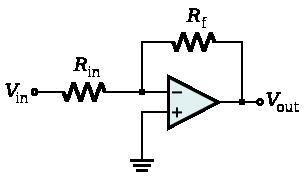Team:Valencia/Hardware
From 2009.igem.org
Hardware
[under construction. Feel free to read an article while its being developed]
Our team prides itself in finding ways to link electronics to biology in a direct and innovative fashion. As a consequence we spent considerable time developing circuits and equipment allowing for quick and robust control of cellular physiology.
- Direct electrical stimulation of cells
The first part of hardware design is an electronic amplifier capable of delivering range of voltages between 0 and 13 volts. It is based on an inverting amplifier (fig. 1). The input voltage comes from a sound card – a commonly accessible and low cost digital to analog converter. It allows us to control the waveform in an arbitrary fashion using a simple Matlab script.
The output is connected to platinum electrodes inserted into a buffer over either muscular, neuronal or yeast cells. We stimulate cells with delta-function pulses every second (or a few of them) to get continuous calcium influx. While muscular and neuronal cells respond to this kind of stimulus naturally, yeast will require some work. We hope that electrical stimulation of yeast could be obtained thanks to a heat-shock response (read more in modeling section) or reported calcium response to electroporation.
This design only allows for stimulating one channel at once. While it is useful for proof-of-principle experiments, if we want to make a working screen, we will need an array of electrodes connected to a multiplexer. We are currently developing a device capable of stimulating tens of pixels at once.
Chemical stimulation controlled by a computer.
We are also developing a chemical stimulator – allowing for dropping calcium-wave inducing chemicals onto cells. This is a backup approach in case electrical stimulation does not give us satisfactory results. The best approach currently is use of a printer cartridge which can drop 300 hundred picoliter-sized droplets within a fraction of a second. Such a cartridge controlled by a computer allows us to literarily “print” the image on the cells by a single mouse click.
 "
"
